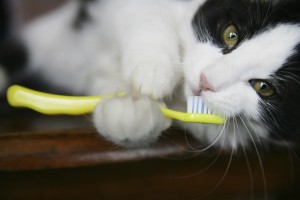Say Cheese! The Benefits of Pet Dental Care
 Getting to the bottom of a pet’s ailment can often be as easy as looking inside the mouth. Painful oral infections can lead to serious health issues; however, with regular dental maintenance, your pet may avoid certain problems related to poor dental hygiene and even lead a longer life.
Getting to the bottom of a pet’s ailment can often be as easy as looking inside the mouth. Painful oral infections can lead to serious health issues; however, with regular dental maintenance, your pet may avoid certain problems related to poor dental hygiene and even lead a longer life.
Let’s explore how pet owners, through easy pet dental care habits, can help bolster increased pet health and longevity.
Why Pet Dental Care Matters
Prevention of periodontal disease is critical to your pet’s health. Most pets over the age of three show signs of plaque and tartar buildup, which eventually leads to one of four stages of periodontal disease (ranging from stage 1 gingivitis, to stage 4 tooth removal). Avoiding the risks associated with periodontal disease will allow your pet to lead a longer, healthier life.
The Risks of Poor Dental Health
If your pet has a long-standing oral infection, he or she may also suffer from kidney, liver, or heart disease as a result of high levels of bacteria entering the bloodstream through inflamed or bleeding gums.
Advanced stages of periodontal disease can lead to:
- Bone loss around the teeth
- Loose teeth
- Nasal discharge
- Jaw fractures
Periodontal infections can also lead to tooth root abscesses, jaw fractures, and oral cancers (among other problems); symptoms of the disease may appear as:
- Bad breath
- Loss of appetite
- Chewing difficulty
- Dropping food
- Inflamed or bleeding gums
- Excessive drooling
- Pawing at the face
- Discolored, missing, broken, or loose teeth
- A change in preference from dry to wet food
The painful symptoms of periodontal disease and can be mitigated with home care, exams, and cleanings.
Providing Pet Dental Care At Home
Your pet may need some convincing that regular teeth brushing is not akin to pet torture. Grooming, extra time outside, and cuddles may help before or after tooth brushing to help make a positive association.
- Purchase a soft-bristled pet toothbrush and a pet-approved toothpaste flavor, such as bacon or poultry, and ease into the process
- Allow your pet to sniff out or taste the toothbrush and toothpaste
- A few seconds of brushing at a time is a great way to begin; eventually 2 minutes total (1 minute for each upper and lower teeth) is optimal for brushing
- Concentrate on upper, outer molars which is where most tarter build-up occurs
Additionally, you may decide to choose from the list of approved products that include rinses, dental chews, and treats to supplement your pet’s brushing.
Professional Dental Care
We are proud to offer dental care as one of our comprehensive pet care services. Digital X-rays will offer a complete view of any problems and help enormously when approaching a cleaning or procedure. Anesthesia is part of a safe and effective dental procedure and your pet will be closely monitored. We understand that this concerns many pet owners and will try to answer all of your questions prior to and during your pet’s treatment.
The Scope of Pet Dental Care
Most people are fastidious with their own dental hygiene, but many pets do not receive the same attention. We can help stop that trend by daily observation and brushing at home along with yearly or bi-annual exams and cleanings. Schedule your pet’s appointment today and we’ll get started!

